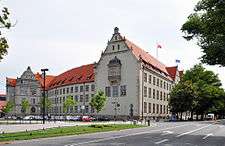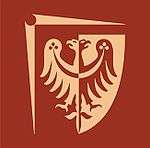Wrocław University of Science and Technology
| Politechnika Wrocławska | |
 | |
| Latin: Polytechnica Wratislaviensis | |
Former names |
Königliche Technische Hochschule Breslau (1910–1918) |
|---|---|
| Type | Public |
| Established |
1910 (former) 1945 (current) |
| Budget | PLN 613 million (2012)[1] |
| Rector | Cezary Madryas |
Academic staff | 2,097 |
| Students | 34,104 |
| 1,032 | |
| Location |
Wrocław, Poland 51°06′25″N 17°03′43″E / 51.107°N 17.062°E |
| Campus | Urban |
| Affiliations | EUA (European University Association), TIME (Top Industrial Managers for Europe), CRE (Association of European Universities CRE-Columbus), EAIE, PACE (Partners for the Advancement of Collaborative Engineering Education) |
| Website | http://www.pwr.edu.pl |
 | |
| University rankings | |
|---|---|
| Global | |
| QS[2] | 251-300 in electrical & electronic engineering |
| Times[3] | N/A |
Wrocław University of Science and Technology (Polish: Politechnika Wrocławska, founded as German: Technische Hochschule Breslau) is an autonomous technical university in Wrocław, Poland. With buildings dispersed throughout the city, its main facilities are gathered at a central location near Plac Grunwaldzki, alongside the Oder river. It operates three regional branches in Jelenia Góra, Legnica, and Wałbrzych.
Students and staff
Currently the university educates over 32,000 students in almost 50 Bachelor, Master, and PhD programs. Every year over 4,000 degrees are conferred, with over 80,000 graduates since its foundation. The university staff consists of over 2000 academic employees and another 2,000 administration workers.
Rankings
Today, it belongs to the best technical universities in Poland: It rates high in the annual rankings of Polish universities. In 2006 and 2007, it was announced the best technical university in Poland in the oldest Polish ranking of higher education schools carried out by Wprost magazine and second best in 2013. The university ranked first in the modern technologies group (disciplines: computer science, electronics, materials science) of the Where to study? ranking. It ranked second among the best technical universities in information technology and the most innovative universities by 2012 Computerworld Magazine. In 2015 it ranked 1st in the field of Environmental Engineering according to currently the most popular ranking sites in Poland, Perspektywy.[4]
It ranked 577, in 2016 Webometrics Ranking of World Universities, 254 in Europe and sixth in Poland.[5]
 C13 Building.
C13 Building.- D20 Building - Faculty of Electrical Engineering.
.jpg) E1 Building - Faculty of Architecture.
E1 Building - Faculty of Architecture..jpg) A2 Building - Faculty of Chemistry.
A2 Building - Faculty of Chemistry.
History
The Technische Hochschule Breslau was founded in 1910 with German scientists and engineers, with the support of Emperor Wilhelm II of the German Empire. It was renowned for its accomplishments and innovation and inventions.
In May 1945, the Festung Breslau was overrun by the Red Army of the Soviet Union and the Technical University of Breslau along with the city was ceded to the People's Republic of Poland.
The Polish Wrocław University of Technology was founded 24 August 1945. A group of 27 professors, originating from the University and Technical University of Lwów, arrived in Wrocław and started the Polish academic society in the destroyed or severely damaged buildings of the Technische Hochschule Breslau. The first lecture was given by Kazimierz Idaszewski on 15 November 1945. Since then that day has been celebrated as Wrocław Science Day.
In 1951 the university was divided into two institutions. The first rector of the newly established Wrocław University of Technology was Dionizy Smoleński. From this moment, the polytechnic developed quickly and underwent numerous organisational changes.
Nowadays students of this university take part in several science programmes such as SSETI Program — developing communication systems and steering for a satellite launched 5 October 2005.
The university is one of the founder of the International University of Logistics and Transport In Wrocław, with the city of Wrocław and the French university École supérieure internationale de commerce in Metz.[6]
Organization
Wroclaw University of Technology is managed by a rector and five vice-rectors: for research, education, students’ affairs, general affairs and development. Rectors and vice-rectors, as well as deans and directors of the departments are elected by the staff for five-year terms and may be re-elected once. The highest governing body within the university is the Senate, which consists of 75 members: rector, 5 vice-rectors, 12 deans, 12 students and 45 eligible staff representatives.
Faculties
The university offers education in a diverse range of fields at 13 faculties:
- 1. Faculty of Architecture
- Architecture and Urban Planning
- Spatial Planning
- 2. Faculty of Civil Engineering
- Civil Engineering
- 3. Faculty of Chemistry
- Biotechnology
- Chemistry
- Chemical and Process Engineering
- Materials Science and Engineering
- Chemical Technology
- 4. Faculty of Electronics
- Control Engineering and Robotics
- Electronics
- Telecommunications
- Computer Science
- Teleinformatics
- 5. Faculty of Electrical Engineering
- Control Engineering and Robotics
- Electrical Engineering
- Mechatronics
- 6. Faculty of Geoengineering, Mining and Geology
- Mining and Geology
- Geodesy and Cartography
- 7. Faculty of Environmental Engineering
- Environmental Engineering
- Environmental Protection
- 8. Faculty of Computer Science and Management
- Computer Science
- Management
- Systems Engineering
- 9. Faculty of Mechanical and Power Engineering
- Mechanical Engineering and Machine Building
- Energy Engineering
- 10. Faculty of Mechanical Engineering
- Control Engineering and Robotics
- Mechanical Engineering
- Transport
- Production Engineering and Management
- Mechatronics
- Biomedical Engineering
- 11. Faculty of Fundamental Problems of Technology
- Physics
- Engineering physics
- Computer Science
- Biomedical Engineering
- Optics
- 12. Faculty of Microsystem Electronics and Photonics
- Electronics and Telecommunications
- Mechatronics
- 13. Faculty of Mathematics
- Mathematics
- Applied mathematics
Rectors
- Rudolf Schenck (1910–1914)
- Gerhard Hessenberg (1914–1916)
- Carl Heinel (1916–1918)
- Friedrich Wilhelm Semmler (1918–1920)
- Ludwig Mann (1920–1924)
- Werner Schmeidler (1924–1926)
- Wilhelm Tafel (1926–1928)
- Karl Gottwein (1928–1930)
- Erich Waetzmann (1930–1932)
- Bernhard Neumann (1932–1933)
- Wilhelm Rein (1933–1937)
- Erwin Ferber (1937–1944)
- Heinrich Blecken (1944–1945)
- Stanisław Kulczyński (1945–1951)
- Dionizy Smoleński (1951–1960)
- Zygmunt Szparkowski (1960–1969)
- Tadeusz Porębski (1969–1980)
- Bogusław Kędzia (1 XII 1980-31 VIII 1981)
- Tadeusz Zipser (1 IX-29 XII 1981)
- Jerzy Schroeder (6 I-31 VII 1982)
- Wacław Kasprzak (1982–1984)
- Jan Kmita (1984–1990)
- Andrzej Wiszniewski (1990–1996)
- Andrzej Mulak (1996–2002)
- Tadeusz Luty (2002–2008)
- Tadeusz Więckowski (2008–2016)
- Cezary Madryas (2016-)
Student life
Students have their own self-government, which controls most of their affairs. At the university works also the Career Office which helps students in transition process from education to work.[7]
Student organizations
Active organizations
- ASI – University Computer Science Association
- AZS – University Sport Association
- AIESEC – International Association of the Economy and Commerce Students’
- BEST – Board of European Students of Technology
- ESN – Erasmus Student Network
- IAESTE – The International Association for the Exchange of Students for the Technical Experience
- IACES – International Association of Civil Engineering Students
- NZS – Independent Students’ Union
- AKM Apanonar – Academic Motors Club
European cooperation networks
- Neisse University: 2001, in cooperation with the Technical University of Liberec in Czech Republic and the University of Applied Sciences Zittau/Goerlitz in Germany, the Neisse University was established. The academic network provides own study courses using the resources of the partner institutes. In that way students study in three countries and acquire intercultural and interdisciplinary knowledge and experiences.
- Top Industrial Managers for Europe: The university participate to student mobility and research cooperations with European technology universities through the Top Industrial Managers for Europe (TIME) network.
International cooperation
- Power Engineering Graduate Program – Double master's degree with Ryerson University
- Joint Master-Program "Information Technology" with Ostwestfalen-Lippe University of Applied Sciences, Halmstad University and Aalborg University.
Centres
- Wroclaw Centre for Networking and Supercomputing
- Networking and Supercomputing services for local universities
- Wroclaw Centre for Technology Transfer
- to increase the efficiency and the competitiveness of industry through innovation
- Lower Silesia Centre for Advanced Technology
- promotion of clean technologies, hydrogen and fuel cells, food safety
- Centre of Advanced Materials and Nanotechnology
- GaN devices, delta-doped structures, scanning probe microscopy, polymers
- Centre of Biomedical Engineering
- Hugo Steinhaus Center
- The goal of the Hugo Steinhaus Center is to organize, encourage and support research on and education in stochastic techniques as applied in science and technology
- Centre of Advanced Manufacturing Technology (CAMT)
- Center of Biomonitoring, Biotechnology and Ecosystems Protection in Lower Silesia
Conferences
- The 7th European Meeting coinciding with the 1st World Meeting in Visual and Physiological Optics, VPOptics 2014
- Modern Electric Power Systems MEPS
- International Conference "Experimental Vibration Analysis for Civil Engineering Structures" – EVACES
- Energy Efficiency and Air Pollutants Control Conference
Notable faculty and alumni
- Krzysztof Baranowski – yachtsman, sailor
- Constantin Carathéodory – Greek mathematician
- Klaus Clusius – physical chemist
- Leszek Czarnecki – businessman and billionaire
- Rafał Dutkiewicz – president of the City of Wrocław
- Arnold Eucken – chemist
- Erwin Fues – theoretical physicist
- Wojciech Kurtyka – climber
- Krystyn Jerzy Haich – architect, engineer, philanthropist
- Jerzy Leszczyński – chemist received the Presidential Award for Excellence in Mathematics and Science Teaching
- Jan Paweł Nowacki – electrical engineer
- Ferdinand Albin Pax – botanist and entomologist.
- Ulrich Petersen (1907–1992), famous expert of iron technology
- Eugen Piwowarsky – metallurgist
- Wanda Rutkiewicz – one of the greatest woman mountaineers
- Hugo Steinhaus – mathematician
- Władysław Ślebodziński – mathematician
- Czesław Ryll-Nardzewski – mathematician
- Włodzimierz Trzebiatowski – physicist, chemist and mathematician
- Stanisław Tołpa – botanist
- Stanisław Trybuła - mathematician
- Krzysztof Wielicki – mountaineer, the fifth man to climb all fourteen eight-thousanders
- Maja Włoszczowska – World Champion in mountain biking
See also
References
- ↑ http://www.imsig.pl/pdf/2013/181/13193.pdf
- ↑ "QS World University Rankings® 2016/17". Quacquarelli Symonds Limited. 2016. Retrieved September 6, 2016.
- ↑ "World University Rankings 2016-17". THE Education Ltd. Retrieved September 21, 2016.
- ↑ http://www.perspektywy.pl/RSW2015/ranking-kierunkow-studiow/kierunki-techniczne/inzynieria-srodowiska
- ↑ World Universities' ranking on the Web http://webometrics.info/en/Europe/Poland
- ↑ Official site International University of Logistics and Transport in Wrocław
- ↑ SULICH. "Careers Office at Wrocław University of Technology as a Learning Organization". www.academia.edu. Retrieved 2016-02-02.
External links
- Wrocław University of Science and Technology home page (english version)
- SSETI Programme at the Wroclaw University of Technology
Coordinates: 51°06′31.72″N 17°03′35.53″E / 51.1088111°N 17.0598694°E